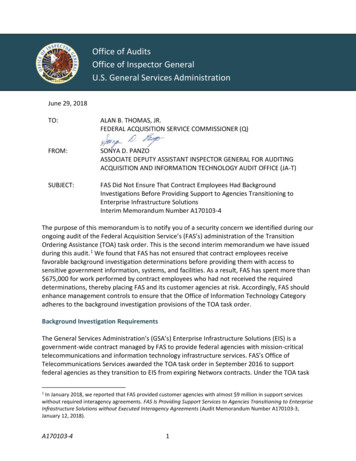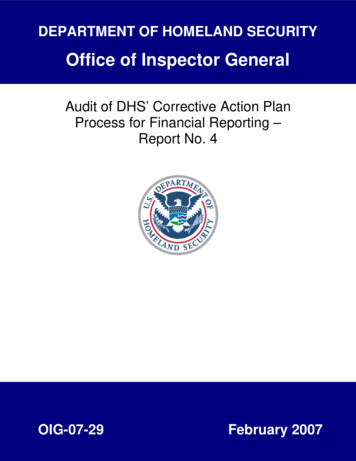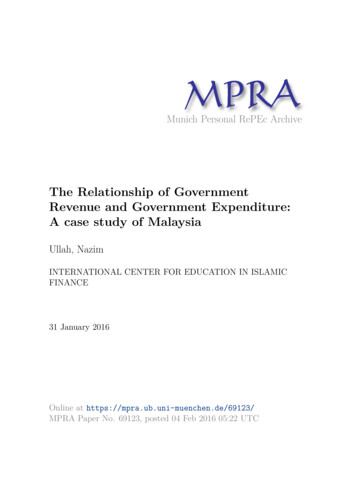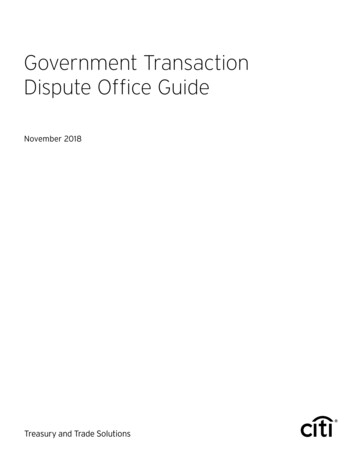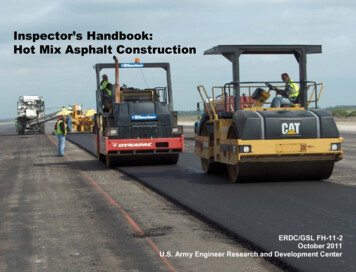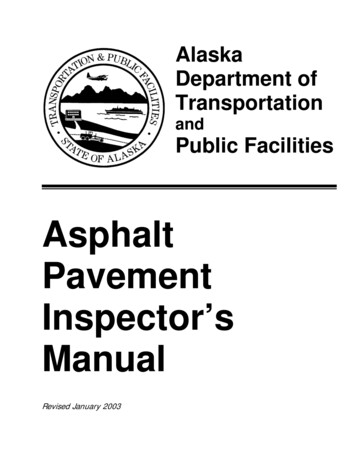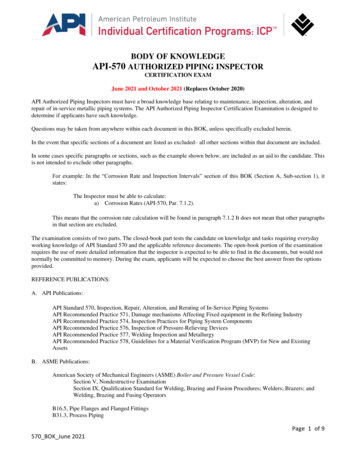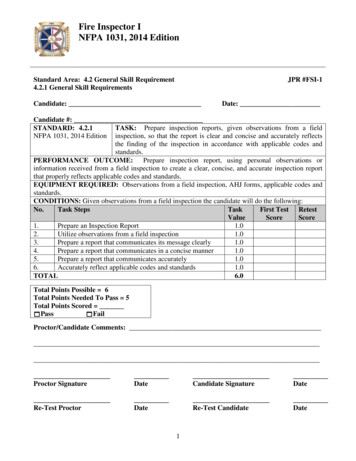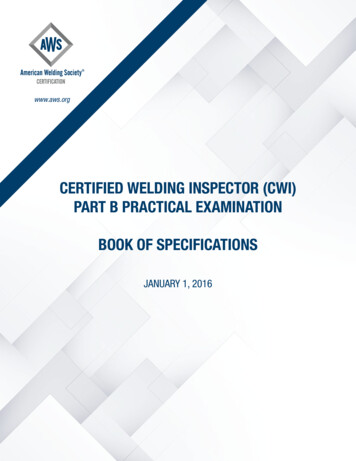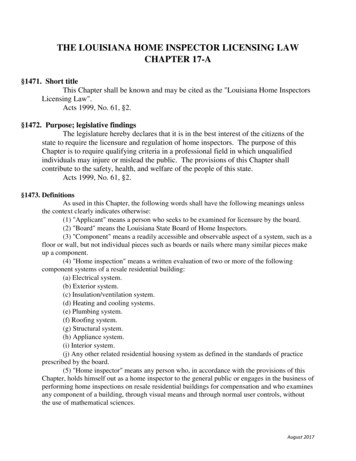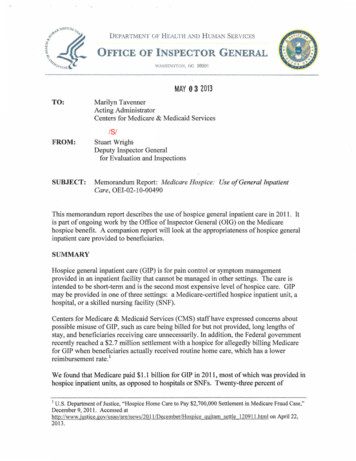
Transcription
DEPARTMENT OF HEALT H AND HUMA.l SERVIC ESOFFICE OF INSPECTOR GENERALWASHI NGTON , DC 2020 1MAY 0 3 2013TO:FROM:SUBJECT:Marilyn TavennerActing AdministratorCenters for Medicare & Medicaid Services/S/Stuart Wright:Deputy Inspector Generalfor Evaluation and InspectionsMemorandum Report: Medicare Hospice : Use ofGenerallnpatientCare, OEI-02-1 0-00490This memorandum report describes the use of hospice general inpatient care in 2011. Itis part of ongoing work by the Office of Inspector General (OIG) on the Medicarehospice benefit. A companion report will look at the appropriateness ofhospice generalinpatient care provided to beneficiaries.SUMMARYHospice general inpatient care (GIP) is for pain control or symptom managementprovided in an inpatient facility that cannot be managed in other settings. The care isintended to be short-term and is the second most expensive level of hospice care. GIPmay be provided in one of three settings: a Medicare-certified hospice inpatient unit, ahospital, or a skilled nursing facility (SNF).Centers for Medicare & Medicaid Services (CMS) staff have expressed concerns aboutpossible misuse of GIP, such as care being billed for but not provided, long lengths ofstay, and beneficiaries receiving care unnecessarily. In addition, the Federal govenunentrecently reached a 2.7 million settlement with a hospice for allegedly billing Medicarefor GIP when beneficiaries actually received routine home care, which has a lowerreimbursement rate . 1We found that Medicare paid 1 .1 billion for GIP in 2011, most of which was provided inhospice inpatient units, as opposed to hospitals or SNFs. Twenty-three percent of1U .S. Department of Justice, "Hospice Home Care to Pay 2,700,000 Settlement in Medicare Fraud Case,"December 9, 2011. Accessed athttp: //www. j usti Q y/usao/are/news/2011/Dec;ember/Hosp ice quita[!Ljlf.ttle 12091l.html on April22,2013 .
Page 2 – Marilyn TavennerMedicare hospice beneficiaries received GIP during the year. One-third of beneficiaries’GIP stays exceeded 5 days, with 11 percent lasting 10 days or more. The hospices thatused inpatient units provided GIP to more of their beneficiaries and for longer periods oftime than hospices that used other settings. We also found that 953 hospices, or27 percent of Medicare hospices, did not provide any GIP to Medicare beneficiaries in2011 and that 429 of these hospices did not provide any level of hospice care other thanroutine home care.These results raise several questions about GIP. Long lengths of stay and the use of GIPin inpatient units need further review to ensure that hospices are using GIP as intendedand providing the appropriate level of care. OIG is committed to looking into theseissues further and will conduct a medical record review that will assess theappropriateness of GIP provided in different settings. CMS should also focus on theseissues as it considers options for hospice payment reform and for developing hospicequality measures. In particular, CMS should focus on hospices that do not provide GIPand ensure that these hospices are providing beneficiaries access to needed levels of careat the end of their lives. One option is for CMS to adopt a quality measure regardinghospices’ ability to provide all hospice services.BACKGROUNDThe goals of hospice care are to help terminally ill beneficiaries continue life withminimal disruption and to support beneficiaries’ families and other caregivers throughoutthe process. The care may be provided to individuals and their families in varioussettings, including a hospice inpatient unit, the home, or other places of residence, such asa SNF or other nursing facility. In 2011, Medicare paid 13.7 billion for hospice care for1.2 million beneficiaries.To be eligible for Medicare hospice care, a beneficiary must be entitled to Part A ofMedicare and be certified as having a terminal illness with a life expectancy of 6 monthsor less if the disease runs its normal course. 2 Upon a beneficiary’s election of hospicecare, the hospice agency assumes the responsibility for medical care related to thebeneficiary’s terminal illness and related conditions. This care is palliative, rather thancurative. It includes, among other things, nursing care, medical social services, hospiceaide services (sometimes referred to as home health aide services), medical supplies(including drugs and biologicals), and physician services. The beneficiary waives allrights to Medicare payment for services related to the curative treatment of the terminalcondition or related conditions but retains rights to Medicare payment for services to treatconditions unrelated to the terminal illness. 3 Beneficiaries may revoke their election ofhospice care and return to standard Medicare coverage at any time. 42Social Security Act, §§ 1814(a)(7)(A) and 1861(dd)(3)(A), 42 U.S.C. §§ 1395f(a)(7)(A) and1395x(dd)(3)(A); 42 CFR §§ 418.20 and 418.22. Certification is based on the physician’s or medicaldirector’s clinical judgment regarding the normal course of the individual’s illness.3Social Security Act, §§ 1812(d)(2)(A) and 1861(dd)(1), 42 U.S.C. §§ 1395d(d)(2)(A) and 1395x(dd)(1);42 CFR § 418.24(d).4Social Security Act, § 1812(d)(2)(B), 42 U.S.C. § 1395d(d)(2)(B); 42 CFR § 418.28.Medicare Hospice: Use of General Inpatient Care (OEI-02-10-00490)
Page 3 – Marilyn TavennerBeneficiaries are entitled to receive hospice care for two 90-day periods, followed by anunlimited number of 60-day periods. 5 The periods need not be consecutive. At the startof each period of care, an attending physician must certify that the beneficiary isterminally ill and has a life expectancy of 6 months or less. For care to be covered underPart A, hospices must be certified by Medicare. 6 In 2011, there were 3,585 Medicarehospices. Of these, 2,071 were for-profit, 1,237 were nonprofit, and 185 weregovernment owned. 7The Medicare hospice benefit is currently undergoing some changes. Per the PatientProtection and Affordable Care Act (ACA), CMS must reform the hospice paymentsystem. 8 Also, CMS must develop quality measures for hospices and hospices mustreport quality data. CMS is currently using two quality measures. The first relates topain management and the second relates to how hospices track patient care. Beginning in2014, hospices must report these measures or face reduced Medicare payments. 9Hospice General Inpatient CareThe Medicare hospice benefit has four levels of care. 10 Each level has an all-inclusivedaily rate that is paid through Part A. The rate is paid to the hospice for each day that abeneficiary is in hospice care, regardless of the number of services furnished. The ratesare adjusted based on the beneficiary’s geographic location.GIP is the second most expensive level of hospice care. As with all covered hospiceservices, hospices are required to provide GIP if the beneficiary needs it. 11 GIP is forpain control or symptom management that cannot be managed in other settings, such asthe beneficiary’s home. 12 GIP is intended to be short-term and may be provided in one ofthree settings: a Medicare-certified hospice inpatient unit, a hospital, or SNF. 13 AMedicare-certified hospice inpatient unit can be freestanding or in space shared withanother health care facility. Medicare-certified hospices with inpatient units must complywith a number of Federal regulations, ranging from staffing to the dispensing of drugs. 14The other three levels of care are routine home care, continuous home care, and inpatientrespite care. Routine home care is the most common. Medicare reimburses the hospiceat this rate for each day that the beneficiary is under the care of the hospice and is notreceiving one of the other levels of care. Continuous home care is allowed only during5Social Security Act, § 1812(a)(4), 42 U.S.C. § 1395d(a)(4). Prior to 1990, Medicare provided hospicecoverage for a maximum of 210 days.6Social Security Act, §§ 1814(a) and 1866, 42 U.S.C. §§ 1395f(a) and 1395cc; 42 CFR § 418.116(a).7We did not have information on ownership status for 92 hospices.8Patient Protection and Affordable Care Act (ACA), P.L. 111-148 § 3132.9ACA, P.L. 111-148 § 3004; 76 Fed. Reg. 47302, 47325–26 (Aug. 4, 2011).1042 CFR § 418.302.11Social Security Act, § 1861(dd)(2)(A)(i), 42 U.S.C. § 1395x(dd)(2)(A)(i).1242 CFR § 418.302(b)(4).1342 CFR § 418.108(a) and (b). For GIP, Medicare regulations do not specify what is meant by “shortterm.”1442 CFR § 418.110.Medicare Hospice: Use of General Inpatient Care (OEI-02-10-00490)
Page 4 – Marilyn Tavennerbrief periods of crisis in which a beneficiary requires continuous care to achievepalliation or management of acute medical symptoms. Inpatient respite care is short-terminpatient care provided to the beneficiary when necessary to relieve the beneficiary’scaregiver(s). It may not be provided consecutively for more than 5 days at a time. 15 SeeTable 1 for the unadjusted payment rates for each level of care in fiscal year (FY) 2011.Table 1: Unadjusted Daily Medicare Hospice PaymentRates by Level of Care, FY 2011Level of CareUnadjustedFY 2011 RateRoutine Home Care 146.63Continuous Home Care 855.79General Inpatient Care 652.27Inpatient Respite Care 151.67Source: CMS, “Update to Hospice Payment Rates, Hospice Cap, Hospice WageIndex, and the Hospice Pricer for FY 2011,” Change Request 7077, July 23, 2010.Inpatient care is subject to an annual cap. Medicare limits the total number of days ofinpatient care (the sum of GIP and inpatient respite care days) for which a hospice maybe reimbursed. The cap is set at 20 percent of the hospice’s total patient care days. 16Related WorkThis report is part of OIG’s continuing work related to Medicare hospice care. Anotherstudy involving a medical record review of general inpatient claims from 2012 willfollow this memorandum report. In 2011, OIG issued a report that found that hospiceswith a high percentage of their Medicare beneficiaries residing in nursing facilitiesreceived more Medicare payments per beneficiary and served beneficiaries who spentmore time in hospice care. 17 Another report determined that Medicare paid an average of 960 per week for hospice care for each beneficiary in a nursing facility. 18 This caremost commonly included nursing, home health aide, and medical social services.Hospices provided an average of 4.2 visits per week for these 3 services combined.OIG also has conducted several studies identifying inappropriate Medicare payments inhospice. OIG found that 82 percent of hospice claims for beneficiaries in nursingfacilities did not meet Medicare coverage requirements. 19 In addition, OIG identified anumber of cases in which the use of inpatient respite care for beneficiaries in nursingfacilities may have been inappropriate. 20 OIG also found instances in which Medicare1542 CFR § 418.302(e)(5).Social Security Act, § 1861(dd)(2)(A)(iii), 42 U.S.C. § 1395x(dd)(2)(A)(iii); 42 CFR § 418.302(f).Excess inpatient care days are reimbursed at the routine home care rate.17OIG, Medicare Hospices That Focus on Nursing Facility Residents, OEI-02-10-00070, July 2011.18OIG, Medicare Hospice Care: Services Provided to Beneficiaries Residing in Nursing Facilities,OEI-02-06-00223, September 2009. Payment for physician services was not included in the analysis.19OIG, Medicare Hospice Care for Beneficiaries in Nursing Facilities: Compliance With MedicareCoverage Requirements, OEI-02-06-00221, September 2009.20OIG, Hospice Beneficiaries’ Use of Respite Care, OEI-02-06-00222, March 2008.16Medicare Hospice: Use of General Inpatient Care (OEI-02-10-00490)
Page 5 – Marilyn Tavennerpaid physicians for services related to a beneficiary’s terminal illness under Part B, whilealso paying for physicians’ services for the terminal illness under Part A. 21In addition, OIG is conducting a study that focuses on discharges from acute carehospitals to hospice care. 22 It will address how a hospital transfer payment policy forearly discharges to hospice care would financially affect the Medicare Part A programand hospitals.METHODOLOGYWe based this memorandum report on an analysis of Medicare Part A hospice claims.To conduct this analysis, we extracted all Medicare Part A hospice claims from CMS’sNational Claims History file that included service dates for hospice care in 2011 and2010. Part A hospice claims typically cover a 1-month period but could be for shorterperiods of time. The level of hospice care, such as GIP, was indicated by a code on theclaim.We analyzed the claims data to identify the hospice beneficiaries who received GIPduring 2011, the number of days that each beneficiary received this care, and the settingin which the care was provided. We also determined from the claims data the terminalillness of each beneficiary. For beneficiaries receiving care at the beginning of 2011, weused hospice claims from 2010 to determine the level of care they received when theystarted hospice care.In addition, we identified all of the Medicare-certified hospices that provided hospicecare in 2011. For each hospice, we determined the number of Medicare hospicebeneficiaries it served, the number of hospice beneficiaries for whom it provided GIP,the settings in which it provided GIP, the number of beneficiaries for whom it providedother levels of hospice care, and the reimbursements it received for GIP and for allhospice care. We determined each hospice’s profit status by using Certification andSurvey Provider Enhanced Reports (CASPER). If CASPER did not show aclassification of for-profit, nonprofit, or government owned for a hospice, we usedinformation available in the Healthcare Cost Report Information System to determine thehospice’s status.We grouped hospices according to the number of Medicare beneficiaries each hospiceserved during the year. We considered a hospice to be large if it provided care to morethan 320 Medicare beneficiaries in 2011. We considered a hospice to be small if itprovided care to 90 or fewer beneficiaries. 2321OIG, Questionable Billing for Physician Services for Hospice Beneficiaries, OEI-02-06-00224,September 2010.22OIG, Medicare Could Save Millions by Implementing a Hospital Transfer Payment Policy for EarlyDischarges to Hospice Care, A-01-12-00507, (forthcoming).23Large hospices were those in the top 30th percentile, whereas small hospices were in the bottom 30thpercentile.Medicare Hospice: Use of General Inpatient Care (OEI-02-10-00490)
Page 6 – Marilyn TavennerFor the purposes of this memorandum, we use the term “GIP stay” to refer to thecontinuous days in which a beneficiary received GIP from the same hospice in the samesetting. To determine the continuous days a beneficiary received care, we combinedclaims for GIP when they were for the same beneficiary in the same setting, from thesame hospice, and the start date of a subsequent claim was the same day or the next dayas the ending date of the previous claim.StandardsThis study was conducted in accordance with the Quality Standards for Inspection andEvaluation issued by the Council of the Inspectors General on Integrity and Efficiency.LimitationsWe based this memorandum report on an analysis of Medicare hospice claims. We didnot conduct a medical record review and did not determine whether services providedwere medically necessary.Medicare Hospice: Use of General Inpatient Care (OEI-02-10-00490)
Page 7 – Marilyn TavennerRESULTSMedicare Paid More Than 1 Billion for Hospice General Inpatient Care in 2011,Most of Which Was Provided in Hospices’ Inpatient Units, as Opposed to Hospitalsor SNFsMedicare paid 1.1 billion for GIP in 2011. This is 8 percent of the total 13.7 billionthat Medicare spent for all hospice care during the year.Most GIP was provided in hospice inpatient units. Fifty-eight percent of GIP stays werein hospice inpatient units, compared to 33 percent in hospitals and 8 percent in SNFs. 24In addition, GIP stays in hospice inpatient units accounted for more than two-thirds of thetotal amount Medicare spent on GIP during the year. In 2011, Medicare paid 738 million for GIP provided in hospice inpatient units, 280 million for GIP providedin hospitals, and 86 million for this care in SNFs. These amounts accounted for67 percent, 25 percent, and 8 percent of all GIP spending, respectively. See Figure 1.Figure 1: Percentages of GIP Stays and Medicare Spending on GIPby Setting, Calendar Year 2011Percentage of GIP Stays and 10%8%0%GIP StaysHospice Inpatient UnitsDollars Spent on GIPHospitalsSNFsSource: OIG analysis of CMS data, 2012.Twenty-three percent of Medicare hospice beneficiaries received GIP in 2011.Seventy-one percent of these beneficiaries received GIP at the start of their time inhospice care. The most common terminal illnesses of beneficiaries who received GIPwere cancer, circulatory disease, respiratory disease, ill-defined conditions, and mentaldisorders. These terminal illnesses were also the most common in the general hospicepopulation.24Because of rounding, these figures do not add to 100 percent.Medicare Hospice: Use of General Inpatient Care (OEI-02-10-00490)
Page 8 – Marilyn TavennerOne-Third of GIP Stays Lasted Longer Than 5 DaysThirty-three percent of GIP stays in 2011 were longer than 5 days, with some lastingmuch longer than 5 days. More specifically, 11 percent of all GIP stays were 10 days ormore. Two percent of all GIP stays continued for over 3 weeks. See Figure 2. Medicarepolicy does not specify a limit on the number of days GIP is allowed, although it isintended to be short-term. The other level of hospice care intended to be short-term,inpatient respite care is limited to 5 consecutive days. Inpatient respite care is used torelieve the beneficiary’s caregiver(s).Figure 2: Percentage of GIP Stays Lasting More Than 5, 10, or 21 Days,Calendar Year 201135%33%Percentage of All GIP Stays30%25%20%15%11%10%5%2%0%More than 5 daysMore than 10 daysMore than 21 daysLength of StaySource: OIG analysis of CMS data, 2012.GIP stays were much less likely to begin on Sunday or Saturday than on a weekday.Eight percent of all GIP stays started on Sundays and 11 percent started on Saturdays,whereas at least 16 percent of GIP stays started on each of the other days of the week.Because GIP is meant for pain control or symptom management that cannot be managedin other settings, we would expect that the percentages of GIP starts during weekend daysand those during weekdays to be similar. 25 In each of the three settings, the lowestpercentage of GIP stays started on Sundays. The difference between Sunday and otherdays was greatest in SNFs, where 5 percent of GIP stays started on Sundays and19 percent started on Fridays. See Appendix A.Unlike the starts of GIP stays, the ends of GIP stays were generally steady throughout theweek. Fourteen percent of GIP stays ended on Sundays and 13 percent on Saturdays.Thirteen to 16 percent of GIP stays ended on each of the other days of the week.25Hospices must make physician and nursing services available (as needed) on a 24-hour basis. SocialSecurity Act, § 1861(dd)(2)(A)(i), 42 U.S.C. § 1395x(dd)(2)(A)(i).Medicare Hospice: Use of General Inpatient Care (OEI-02-10-00490)
Page 9 – Marilyn TavennerHospices That Used Inpatient Units Provided GIP to More of Their Beneficiariesand for Longer Periods of Time Than Hospices That Used Other SettingsTwenty-three percent of all Medicare hospices (809 hospices) provided GIP in inpatientunits. Sixty percent of all Medicare hospices (2,163 hospices) provided GIP in hospitals,and 27 percent (978 hospices) provided GIP in SNFs. 26The 23 percent of hospices that used inpatient units were more likely than other hospicesto provide GIP to their beneficiaries. Hospices that used inpatient units provided GIP to35 percent of their beneficiaries. In contrast, hospices that did not use inpatient units andprovided GIP in hospitals or SNFs did so for 12 percent of their beneficiaries. Hosp
The other three levels of care are routine home care, continuous home care, and inpatient respite care. Routine home care is the most common. Medicare reimburses the hospice at this rate for each day that the beneficiary is under the care of the hospice and is not receiving one of the other levels of care.
